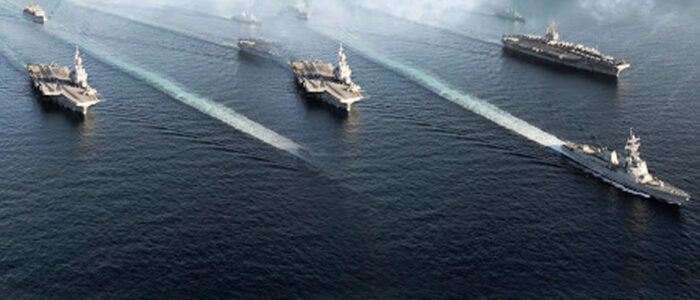Locations of geopolitical importance have constantly shifted throughout the history of international politics and relations. From the heartland in Central Asia, to the Middle East in West Asia and now the most recent area of importance: the Indo-Pacific/Asia-Pacific region. Since India has started making heads turn all over the globe due to its rapid rise in status, countries such as the USA and Australia have started viewing the original Asia-Pacific geographical region PLUS India, thereby making it the Indo-Pacific region. Japan agrees with India that the term Indo-Pacific implies the inclusion of the African continent as well since it is a much broader term than just the “Asia”-Pacific region. Geopolitically it is still in its nascent stage and currently contested by China which refuses to accept the term “Indo” as is observed by the absence of said term in any official Chinese document. However, in reality and practice, China’s endeavours have vehemently emphasized that the CCP greatly understands the importance of the region, showcasing this by its famed BRI initiative. It is safe to assume that China, despite not acknowledging the terminology “Indo-Pacific” officially, has acknowledged it unofficially in practice; the String of Pearls theory also suggests the same.
Strategic Significance
The USA has claimed that the Indo-Pacific region is extremely crucial for securing America’s future. This claim is backed by the fact that the region is home to the South China Sea, which holds an estimated 190 trillion cubic feet of natural gas and 11 billion barrels in proven and probable reserves along with much more potential reserves that remain undiscovered as of yet. The zone also has three very important nations located within it: China, the most populous state and the world’s largest exporter, India, the world’s youngest democracy and the 5th largest economy of the world and Indonesia, the world’s most populous Muslim majority country. Just by these facts alone, it is quite evident why the up and rising Indo-Pacific region will be the hottest geopolitical region for a long time to come (New Regional Geopolitics in the Indo-Pacific: Drivers, Dynamics and Consequences. United Kingdom: Taylor & Francis, 2016. P.45). There is a common thinking amongst the Chinese leaders that the main reason why the United States of America is ferociously advocating for a Free and Open Indo-Pacific is to contain China’s rapid rise to prosperity. A huge fault line can be seen emerging in the Indo-Pacific region. Driven by the USA-China rivalry, this fault line goes along the lines of choosing between Security Protection and Economic Prosperity. This rivalry will most definitely be the reason for change in the international and political order in the region due to most of the traditional American allies such as Japan, South Korea, Australia, Thailand and the Philippines being forced to choose sides to ensure their continued survival and economy. In the backdrop of the Indo-Pacific becoming a geopolitically heated area, there are several other developments that the entire international community is closely monitoring. Firstly, the region houses North Korea, an unpredictable state with nuclear capabilities. Its supreme leader Kim Jong Un has adopted a very adamant stance with regards to resuming talks with the American leadership. Recently it also unveiled its very own strategic weapons system (strategic implies nuclear) along with a colossal missile, the Hwasong-15, with a range of 13,000 Km. With this, the country can reach any part of the USA and Western Europe if it so desires. The concern here is that despite multiple sanctions against it, North Korea is still receiving all the heavy and light components required to build such massive artillery; fingers are pointed towards China. The Second factor, is the dispute plaguing the waters of East China Sea and the South China Sea. The former has witnessed ongoing clashes between China, Japan and South Korea with regards to the extent of their respective Exclusive Economic Zones (EEZ). China has demanded for a just application of the United Nations Convention on the Law of the Sea (UNCLOS) in the East China sea by asking for consideration of the natural prolongation of its own continental shelf, thereby making it extended to as far as the Okinawa Trough. Basically it means that according to China, its EEZ extends beyond the UNCLOS-ratified 200 nautical miles from the baselines from which the width of its territorial sea is measured. This should be applicable as based upon the existing UNCLOS provisions which accept China’s right to the natural shelf, a claim which has been angrily disputed by Japan along with the Philippines. The reason for this dispute is that underneath the seabed of the East China Sea, a natural gas field, namely the Chunxiao gas field (Dai, Jinxing. Giant Coal-Derived Gas Fields and Their Gas Sources in China. Netherlands: Elsevier Science, 2016. P. 532), has been discovered. This gas field lies within the Chinese EEZ while Japan claims that it has substantial evidence that the field may be connected to other possible undiscovered regions beyond the median line. It is important to note that this median line is currently disputed since both countries’ EEZs overlap here. According to the Japanese, although the Chunxiao gas field lies on the Chinese side of this median line (Tokyo considers this line to be the shared sea boundary for the two countries), the field itself maybe connected to other under-the-seabed gas reserves which lie within the disputed area; as such, the Japanese government seeks for a share in the natural gas resources. The third factor can be located in the Spratly Islands dispute in the South China Sea. The Spratly Islands are comprised of 750 small uninhabited islands, barely 4 square kilometres put together, yet contested for ownership by the Philippines, Malaysia, Vietnam, Taiwan and of course, the People’s Republic of China. Despite the fact that these islands are seemingly useless to most of the world’s unaware population, the reason behind such heated arguments for its ownership is in the humongous amounts of gas and oil deposits, rich marine ecosystem and having a strategically important location for military activities. In the past China and Vietnam have military clashed over this area in 1988, resulting in the deaths of at least 64 Vietnamese soldiers. The Philippines have clashed with Malaysia as well in 2013 with regards to ownership of the Spratlies; it is to be noted that currently the Philippines is the most favoured candidate in the international arena in this context. The 1951 United States-Philippines Mutual Peace Treaty signifies that the US is obligated to voice its firm public support for the latter (which happens to be its strongest South East Asian ally); yet the American voice has been incoherent so far. China is actively trying to take advantage of this notion. The fourth factor is the dispute between China and Indonesia with respect to ownership of the Natuna Islands; Indonesia has dismissed China’s nine-dash line claim over parts of this island. China’s unilateral nine-dash line allegedly overlaps the EEZ of Indonesia near the Natuna Islands and as such, while acknowledging the latter’s sovereignty over the islands itself, claims control over the waters surrounding it. Indonesia firmly rejected this statement since it has no legal basis. The fifth and final factor can be divided into two parts: (i) China’s objection towards Indian presence in the South China Sea for oil exploration purposes and (ii) India’s objection towards Chinese naval excursions and build up of military bases in the Indian Ocean and Arabian Sea region.
The China Factor
By now it must be evident that the grand title of the antagonist in the Indo-Pacific region has been awarded to the People’s Republic of China as a direct outcome of its muscle flexing in the South and East China Seas and habit of lurking around in the Indian Ocean to drive India into a corner both economically and militarily. The Indo-Pacific region has become such a large area of contention, that not one, not two, but nearly 20 different disputes plague it, making the area a definite policy imperative. The biggest change in the world’s approach towards the Indo-Pacific is that India is now seen as one of the biggest players in the region. No longer is the nation’s government accused of remaining ignorant of the importance of the oceans and seas. India now fully recognizes the urgency of establishing its presence as a maritime power to be reckoned with. It is interesting to observe the transition of geopolitical areas of interest throughout the history of international order. Until the 1950s, Europe was the global theatre; from the 60s to the 90s it was West Asia, largely due to the presence of the OPEC countries. Now all eyes have been set on the Indo-Pacific which undoubtedly holds the most importance out of all its areas-of-interest-predecessors. Owing to this reality, we have seen multiple state actors starting to promote their national interest in the region in ways they see fit. Some of the most prominent ones here are China, Australia, India and Japan as mentioned earlier as well; of these, China’s rise economically and militarily has put the entire international arena on red-alert mode because of its aggressive policies with regards to challenging the UNCLOS in the South China Sea, signing a 25 years long partnership with the US-sanctioned Iran, debt trapping nations within the Indian Ocean territory, providing moral support to Pakistan’s insurgency sponsoring activities and engaging in direct military clashes with India. As part of its forthcoming BRI initiative, China has started eyeing Syria as well, hoping to take advantage of the situation concerning the American withdrawal of its troops. While Syria gets increasingly embittered with the western powers, China could provide a sufficient counterbalance. China is also a bit tensed about its Uighur crisis in the Xinjiang province; it believes that hundreds or even thousands of Uighur Muslims may have joined the ISIS in the Levant, part of which lies in Eastern Syria. Despite the risky security conditions prevailing in Syria, it is quite safe to assume that Beijing will definitely be looking forward to deepening ties with Damascus because the country also happens to provide a great alternative to the Suez Canal and eventually help in reviving the historic and legendary Silk Route. The economic aspect of the Indo-Pacific is the main driving force behind the global interest in the region and China’s BRI sought to play an active role in it. The BRI was initially readily accepted by a lot of nations but the recent developments have brought to light that perhaps this is an investment that needs more scrutiny as observed by a few instances of cancelled projects or their down-scaling. Taking this into hindsight, one may be able to understand that the same logic can be applied to the Indo-Pacific region as well; since China faces the threat of being backed into a corner by the international community due to a) the covid-19 pandemic b) aggressive naval policies and c) the rise of the Quadrilateral Security Dialogue, Beijing is now scrambling to build new alliances in other parts of Asia as it has done with Pakistan, Cambodia, Iran and Malaysia.
Scope of an Indo-Pacific Security Construct
Among the three factors threatening China, the last one, the Quadrilateral Security Dialogue or simply the more commonly known term, QUAD, is at present, gaining a huge momentum with each passing day. It is an informal strategic platform for four countries, namely, USA, Australia, India and Japan, first established in 2007 but in hibernation until November 2017 when it was officially rejuvenated. Currently it is known as the QUAD 2.0 and is seen as the solution to the China problem by not only its member countries but by other nations including the entire European Union itself. The reasons for the founding of such a “movement” vary with each of the members; Japan is increasingly becoming worried that China may drastically affect its geo-economic interests in the IOR (Indian Ocean Region) since the region accounts for 90% of its oil imports. Also, it has steadily increased its investments in the IOR since 2016 and thus, fears the collapse of its endeavours due to Chinese interference. India too, shares the same concerns with the Japanese since their economic partnership has reached great heights as of now. There is also a fear in New Delhi that the Chinese may be aiming to set up a permanent naval presence in the IOR which would be quite detrimental towards its main goal of Free and Open navigation of the waters. Australia’s stance in this region is a little bit complicated; while it has become apprehensive of the increasing Chinese aggression in the South China Sea, Canberra still finds the holistic view of the Indo-Pacific region to be incoherent in the sense that there is no clear definition to any activity that is being taken here. Australia does recognize some of the economic advantages of being involved in the Indo-Pacific but remains skeptical about its true potential due to the lack of proper infrastructure as well as the absence of any superstructure that could unite the key players of this region. The 2020 Coronavirus pandemic, however has led to the drastic souring of Sino-Australian relations, providing the country “down-under” with the incentive of committing itself to the QUAD 2.0. The QUAD 2.0’s success entirely depends on the levels of commitment from both India and Australia as in the case of the former, its slower than anticipated rise to eminence impeded the smooth transitions within the mechanism. The US President Donald Trump and former Japanese Prime Minister Shinzo Abe were the only ones to maintain a firm stance throughout the entire 2007-2017 period and even now have led the charge to check China’s arbitrary rise; now with the 2020 US elections results declared and Joe Biden as the new President-Elect along with Japan’s new Prime Minister Yoshihide Suga, the future of the QUAD 2.0 is yet to be determined. Prime Minister Narendra Modi has established India’s commitment to the movement and the latest Malabar Naval exercises prove Australia’s willingness as well. External actors have also shown keen interest in getting on board with the QUAD program, namely, Vietnam, Indonesia, UK and France, effectively giving the Indo-Pacific security construct a new life of its own.
Conclusion
The Indo-Pacific terminology will continue to gather momentum and remain at the forefront of geopolitical significance for many years to come possibly decades since it offers a more definite sense of purpose as compared to the “Asia-Pacific”. Strategic points to establish chokeholds on China also happen to exist within this region and given the Dragon’s rapid rise, it could be any moment that it decides to take flight and burn anyone it might consider to be in its path. Hence, this region and all of its residents are crucial actors in determining the fate of geopolitics that is yet to unravel.
References:
- THE FOCUS IS ON INDO-PACIFIC, Capt Gurpreet S Khurana, 2018, July 3rd
- What’s the point of the Quad? John Dobson, 2020, October 18th
- India holds the key to the success of Quad 2.0, India Inc. Staff, 2020, June 4th
- Four reasons why the Indo-Pacific matters in 2020, Kai He and Li Mingjiang, Oxford University Press’s Academic Insights for the Thinking World, 2020, February 7th
- Australia and the Indo-Pacific: A Region in Search of a Strategy, or a Strategy in Search of a Region? Thomas S. Wilkins, ISPI (Istituto per gli Studi di Politica Internazionale), 2018, June 4th





